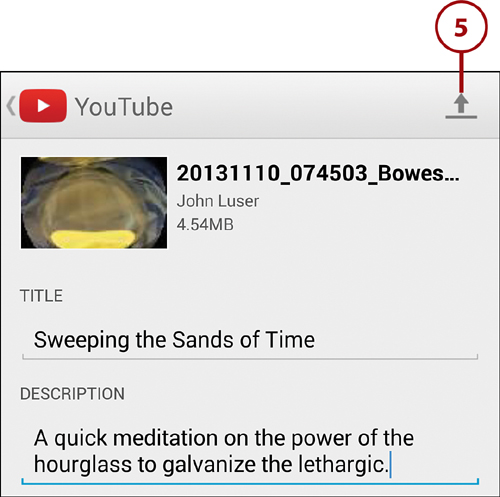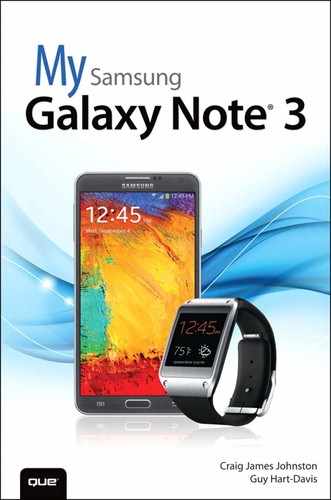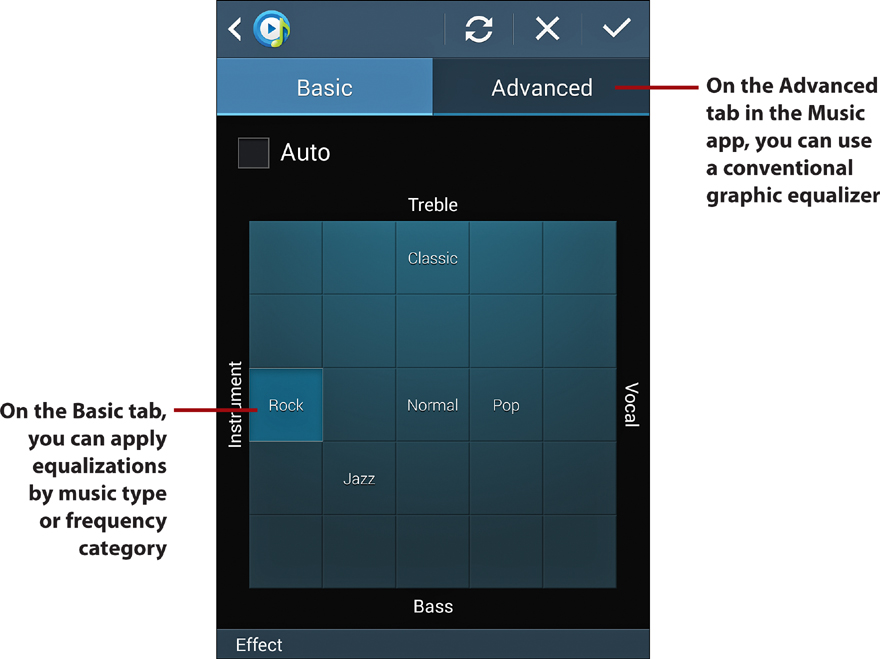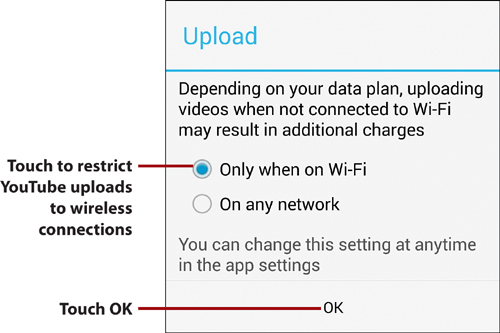9. Audio, Video, Photos, and Movies

In this chapter, you discover your Galaxy Note 3’s audio and video capabilities, including how your Galaxy Note 3 plays video and music, and how you can synchronize audio and video from your desktop or laptop computer or Google Music. This chapter also covers how to take pictures and videos. Topics include the following:
→ Using Google Music for music
→ Using the Gallery app for pictures and video
→ Shooting still photos and videos
→ Enjoying videos with the YouTube app
Your Galaxy Note 3 is a powerful multimedia smartphone with the ability to play back many different audio and video formats. The large screen enables you to turn your Galaxy Note 3 sideways to enjoy a video in its original 16:9 ratio. You can also use your Galaxy Note 3 to take photos and videos, watch videos, and even upload videos to YouTube right from your phone. Android version 4 fully embraces the cloud, which enables you to store your music collection on Google’s servers so you can access it anywhere.
Enjoying Music with the Music Application
To get the most out of music on your Galaxy Note 3, you probably want to use the Play Music app, which enables you to listen to music stored on your phone as well as from your collection in the Google Music cloud.
Find Music
When you’re certain the Play Music app is installed on your Galaxy Note 3, you can add some music. One way to add music is to purchase it from Google.
1. Touch the Play Music icon on the Apps screen or in the Google folder.

2. Touch the headphones icon in the upper-left corner to display the navigation panel.
3. Touch Shop to display the Play Store screen.

5. Swipe right to see a list of music genres.
6. Swipe left or touch Top Albums to see the Top Albums list. Swipe left again from the Top Albums list to see the Top Songs list.
7. Touch to search for music.

Purchase Music
After you find a song or album you want to purchase, use the following steps to make the purchase.
Free Music
Sometimes songs are offered for free. If a song is offered for free, you see the word Free instead of a price for the song. Even though the song is free, you still need to follow the steps outlined in this section; however, the price appears as 0.
1. Touch the price to the right of the song title or album.

2. Touch Buy. Google Play processes your payment, and Play Music downloads the song. You can then play it.

Add Your Existing Music to Google Music
You can upload up to 20,000 songs from Apple iTunes, Microsoft Windows Media Player, or music stored in folders on your computer to your Google Music cloud account by using the Google Music Manager app on your desktop computer. If you haven’t already installed Google Music Manager, please follow the steps in the “Install Google Music Manager” section in the Prologue.
1. Click (right-click for Windows) the Google Music Manager icon. On the Mac, this icon appears in the menu bar at the top of the screen. On Windows, the icon appears in the taskbar at the bottom of the screen.
2. Choose Preferences on the Mac; choose Options on Windows.
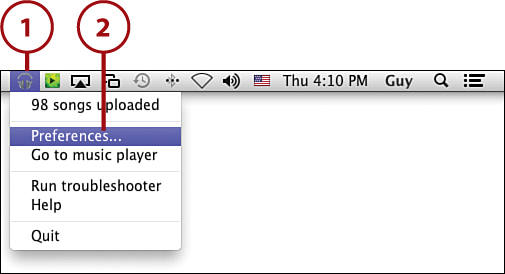
3. Click Add Folder to add a folder of music to upload.
4. Click Remove Folder to remove the folder you have selected in the list box from your Google Play account.
5. Click Upload after you have made your selections.
6. Select this check box to allow Google Music Manager to automatically upload new songs added to the folders you have specified.
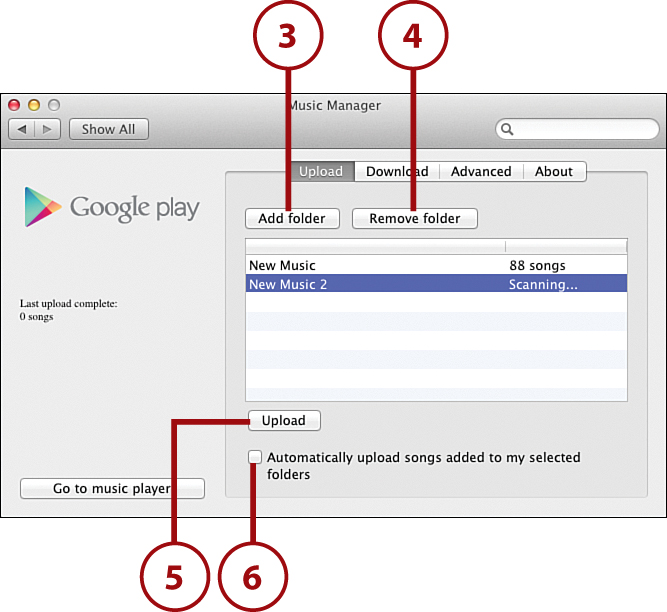
If you choose to have your music uploaded automatically in step 6, Google Music Manager continually monitors your Music folders to see if music has been added. If Google Music Manager finds new music, it automatically uploads it. After you install Google Music Manager, the app runs continuously, enabling it to detect music you add to iTunes, Windows Media Player, or your Music folders.
Can I Download Music to My Computer?
You can download your entire music collection from Google Music to your computer, or just download music you have purchased on your Galaxy Note 3. While in Google Music Manager Preferences, click Download.

Use the Music Application
Now that you have synced some music to Google Music, and maybe bought some music online, it’s time to take a look at how to use the Google Music app on your Galaxy Note 3.
Open and Navigate in the Music App
1. Touch the Play Music icon on the Apps screen or in the Google folder.

2. Touch the headphones icon in the upper-left corner to display the navigation panel. This panel enables you to switch among your different sources of music. You can also swipe right to display the navigation panel.
3. Touch Listen Now in the navigation panel to display the Listen Now screen, which contains music you have added recently. Listen Now also recommends music to you based on the music you have and your recent listening habits.
4. Touch My Library to display your music library. Your library contains both the music on your Galaxy Note 3 and the music in your Google account.
5. Touch Playlists to display the Playlists screen. The Play Music app automatically creates some playlists for you, and you can manually create as many other playlists as you want. Read more about playlists later in this chapter.
6. Touch Instant Mixes to display the Instant Mixes screen, which contains both instant mixes you create yourself and ones that Google Play recommends to you. An instant mix is a selection of songs based on—and supposedly related to—a particular starting song. For example, you can create an instant mix based on “Berzerk” or “Blurred Lines.”
7. Touch Shop to switch to the Play Store app and go to the Music section of Google Play, where you can browse and buy music as explained earlier in this chapter.
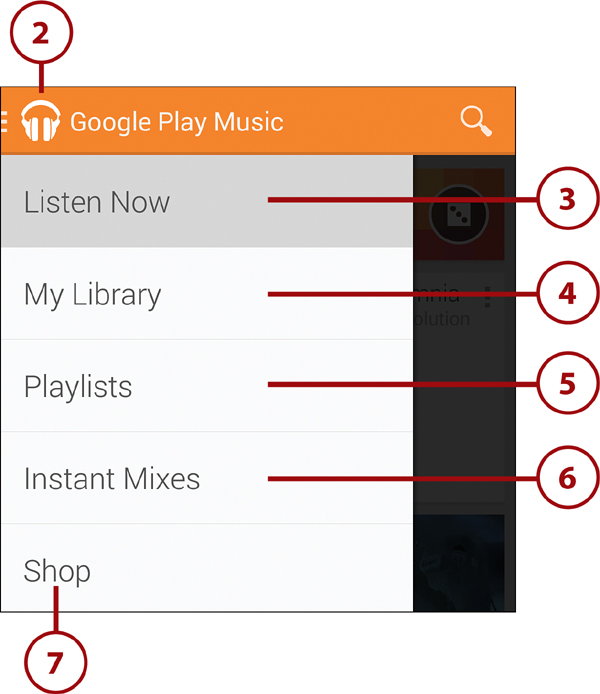
Listen to Music in Your Library
1. Touch the headphones icon in the upper-left corner to display the navigation panel and then touch My Library to display your music library.
2. Touch to display a pop-up menu that enables you to switch between all your music (touch All Music) and only the music on your Galaxy Note 3 (touch On Device).
3. Touch to search for music using search terms.
4. Touch Genres to display the list of genres. You can then touch the genre by which you want to browse your library.
5. Touch Artists to display the list of artists so you can browse by artists.
6. Touch Albums to display the list of albums so you can browse by albums.
7. Touch Songs to display the list of songs. You can then easily locate a song by name in the alphabetical list.
8. Touch the Menu button on an item to display a pop-up menu of commands you can perform for that item. In this example, you can start an instant mix for this artist or shop the artist’s music at the Play Store.
9. Touch the Play button or Pause button to control playback on the current song or most recent song played.
10. Touch an artist to display the albums and songs your library contains by that artist.
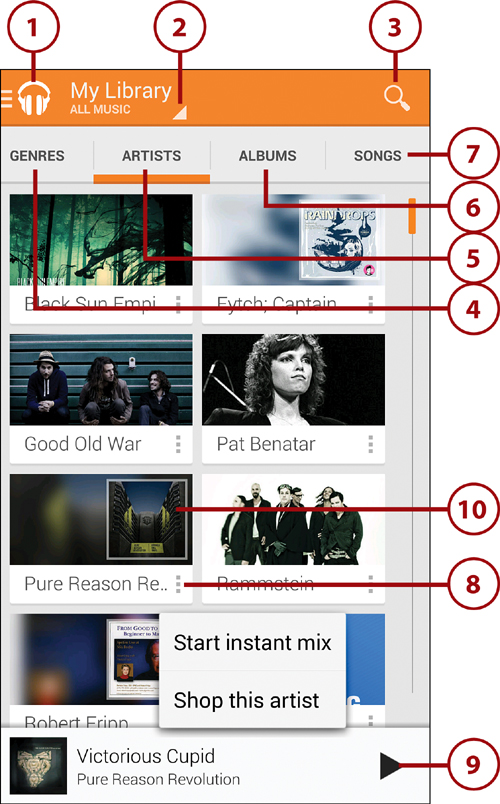
11. Touch the album you want to open. The album’s songs appear.
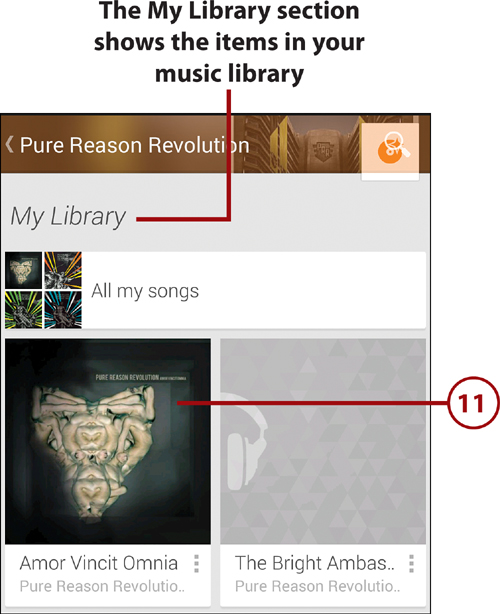
12. Touch the song you want to start playing.
13. Touch Pause to pause playback. Touch the resulting Play button to start the music playing again.
14. Touch the album picture to display the Now Playing screen, which gives you full control of your music, as explained in the next section.

Control Playback
While playing music, you can control both how the music plays and the selection of music that plays.
1. Touch to display the queue, which shows the songs that are lined up to play. You can then touch a song to start it playing.
2. Touch to return from the Now Playing screen to the previous screen.
3. Touch to indicate you like the song. The thumbs-up icon turns solid to indicate you have applied the rating. Touch again to remove the rating. The Google Music app also adds the song to the “Thumbs Up” playlist.
4. Touch to indicate you do not like the song. The thumbs-down icon turns solid to indicate you have applied the rating, and Play Music starts playing the next song.
5. Touch once to go back to the start of the current song. Touch again to skip back to the previous song in the album, playlist, or shuffle.
6. Touch to skip ahead to the next song in the album, playlist, or shuffle.
7. Touch to pause the song. The button turns into the Play button when a song is paused. Touch again to resume playing a paused song.
8. Touch and drag the Playhead to change the position in the song.

9. Touch to enable or disable song shuffling. When Shuffle is enabled, songs in the current playlist, album, or song list are randomly played.
10. Touch to enable repeating. Touch once to repeat all songs, touch again to repeat the current song only, and touch a third time to disable repeating.


11. Touch the Menu button to display the menu of actions you can take with the song.
12. Touch to start an instant mix based on the song.
13. Touch to add the song to a playlist. In the Add to Playlist dialog that opens, you can either touch New Playlist to start creating a new playlist or touch the name of an existing playlist to use that playlist.
14. Touch Go to Artist to display the artist the song is by.
15. Touch Go to Album to display the album the song is on.
16. Touch Clear Queue to clear the playback queue.
17. Touch Save Queue to save the playback queue. In the Add to Playlist dialog that opens, you can either touch New Playlist to create a new playlist containing the songs on the queue or touch the name of an existing playlist to add the songs to that playlist.

If you are playing a song and choose to create an instant mix as mentioned in step 12, the Google Music app creates a new playlist and adds songs to it that are similar to the one you are currently playing. The name of the playlist is the name of the current song plus the word mix. For example, if you are playing the song “Piquant” and choose to create an instant mix, the playlist is called “Piquant Mix.”
Work and Listen to Music
You don’t have to keep the Play Music app displayed while you are playing music. Instead, you can switch back to the Home screen and run any other app but still have the ability to control the music.
1. Pull down the Notification bar.
2. Touch to pause the song.
3. Touch to skip ahead to the next song in the list, album, or playlist.
4. Touch the song title or the album art to open the Google Music app for more control.
5. Touch to stop playing the song and remove the playback control from the Notification screen.

What If I Get a Call?
If someone calls you while you are listening to music, your Galaxy Note 3 pauses the music and displays the regular incoming call screen. After you hang up, the music continues playing.
Work with Playlists
Playlists can be a great way of listening to music, enabling you to group together related songs or simply those you want to hear in a particular sequence. On your Galaxy Note 3, you can create new playlists, add songs to existing playlists, rename playlists, and change the order of the songs they contain.
Create a New Playlist on Your Galaxy Note 3
1. Using the techniques described earlier in this chapter, navigate to a song you want to add to the new playlist.
2. Touch the song’s Menu button to display the menu of actions you can take with the song.
3. Touch Add to Playlist. The Add to Playlist dialog opens.

4. Touch New Playlist. The Playlist Name dialog opens.

5. Type the name for the new playlist.
6. Touch OK.

Add a Song to an Existing Playlist
1. Using the techniques described earlier in this chapter, navigate to a song you want to add to the new playlist. You can also use the song on the Now Playing screen, as in this example.
2. Touch the song’s Menu button to open the menu of actions you can take with the song.
3. Touch Add to Playlist. The Add to Playlist dialog opens.

4. Touch the playlist you want to add the song to.
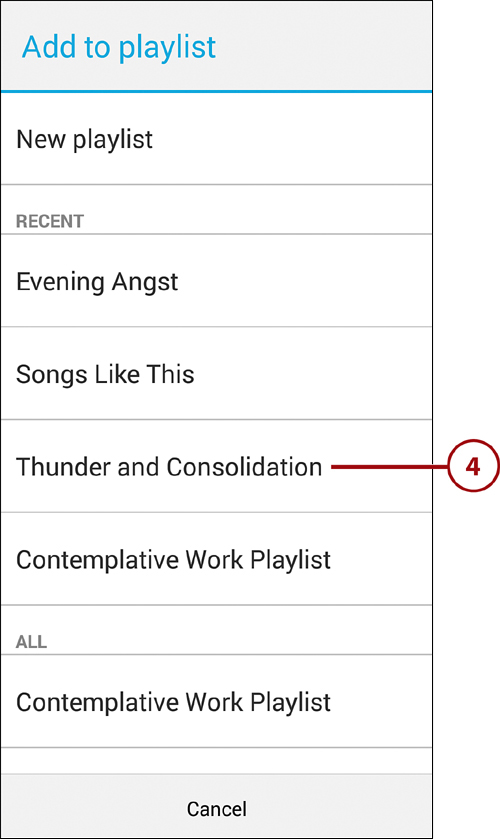
Delete a Playlist
When you no longer need a playlist, you can delete it in moments. Deleting the playlist doesn’t delete its songs—only the list is deleted.
1. Touch the icon in the upper-left corner of the screen to display the navigation panel, and then touch Playlists to display the Playlists screen.
2. Touch the Menu button for the playlist you want to delete.
3. Touch Delete. A confirmation dialog opens.

4. Touch OK.

Renaming a Playlist
At this writing, the Play Music app doesn’t provide a command for renaming a playlist. To work around this, create a new, empty playlist with the new name. Then touch the Menu button for the playlist you want to rename, touch Add to Playlist to display the Add to Playlist dialog, and then touch your new playlist to place the existing playlist’s contents in the new playlist. You can now delete the old playlist and use the new playlist instead.
Rearrange the Songs in a Playlist
You can keep a playlist fresh by adding songs to it as explained earlier in this chapter, but you can also delete songs from the playlist and rearrange the songs it contains.
1. On the Playlists screen, touch the playlist to display its songs.

2. Touch and hold the three-line handle to the left of the song you want to move. Drag the song up or down until it is in the right place and then release it.
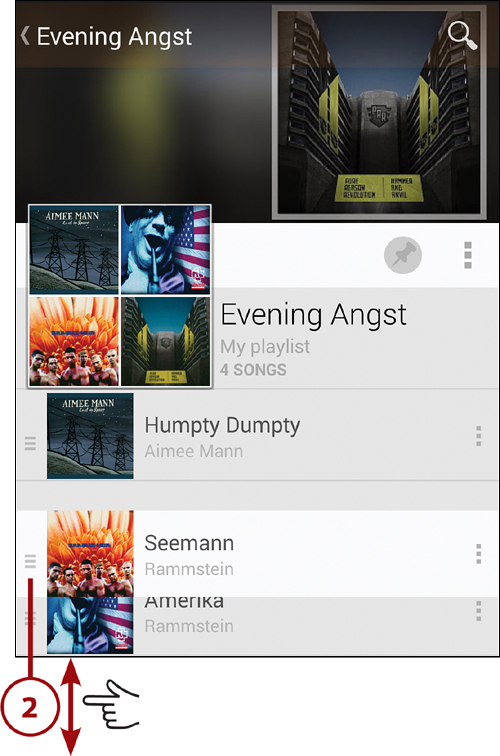
3. To remove a song, swipe it to the left or to the right. You can also touch its menu button and then touch Remove from Playlist.

Listen to Music with No Wireless Coverage
If you use Google Music and store your music online, your Galaxy Note 3 streams the music over the cellular or Wi-Fi network when you play the music. If you know you are going to be without a signal but still want to listen to your music, you need to store it on your Galaxy Note 3.
1. Using the techniques discussed earlier in this chapter, go to the music you want to store on your Galaxy Note 3.
2. Touch the gray pushpin, which indicates that the music is not stored on your Galaxy Note 3.

3. The Play Music app downloads and stores the music. As it does so, the pushpin displays a progress indicator. When the music is available, the pushpin appears on an orange background.

Playing and Sharing Videos
The Gallery app enables you to view pictures and video; you can also share pictures and video with people on Facebook, or via MMS, Bluetooth, YouTube, and email. This section explains how you can view and share videos.
Understanding the Two Ways to Access Videos
Your Galaxy Note 3 enables you to access videos in two main ways: through the Gallery app or through the Videos app. This section shows you how to use the Gallery app, which enables you to review your photos and videos at the same time and choose which to use or view. From the Gallery app, you can open the video for viewing in either the Photos app, as explained here, or in the Videos app.
This section explains how to view and share videos. Later in this chapter, you learn how to take pictures and share them.
1. Touch the Gallery icon on the Apps screen to launch the Gallery app.

2. Touch the navigation pop-up menu in the upper-left corner.
3. Touch the category you want to see. Your choices are Albums, All, Time, Locations, People, and Favorites. This example uses Albums.

4. Touch an album to open it, revealing the pictures and videos it contains.
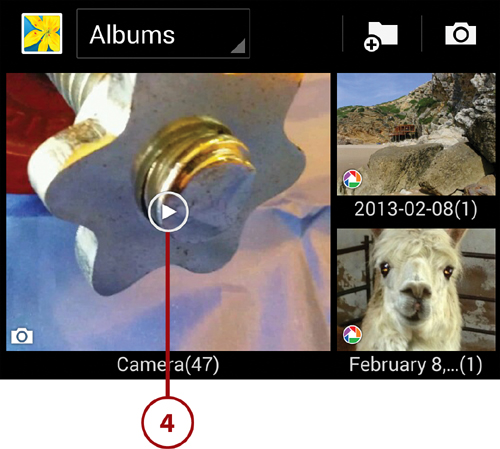
5. Touch a video to open it for playback. Videos have a little Play icon on them.

6. Touch the Play icon to start the video playing.
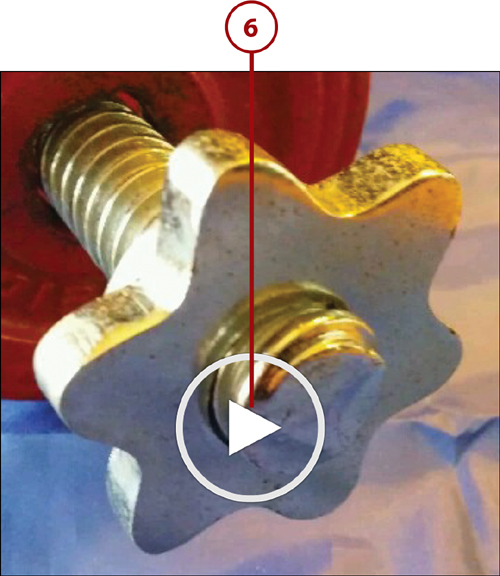
Choosing the App to Use for Playing Videos
The first time you tap the Play icon for a video in the Gallery app, your Galaxy Note 3 displays the Complete Action Using dialog to let you choose between the available video players. Normally, these are the Photos app and the Video Player app, but you might have installed other video-capable apps on your Galaxy Note 3.
Touch the app you want to use. Then touch Always if you want to always use that app. Touch Just Once if you want your Galaxy Note 3 to prompt you again in the future.

7. Touch the screen while the video is playing to reveal the video controls. If you do not use the controls, they disappear after a few seconds.
8. Touch to pause or unpause the video.
9. Drag the slider to scrub quickly forward and backward.
10. Touch to skip to the end of the video.
11. Touch to return to the beginning of the video.
12. Touch to switch between viewing the video full screen and viewing it as best fits the Galaxy Note 3’s screen.
13. Touch to display the video in a pop-up window. You can then switch to another screen and continue to watch the video as you work or play.

Changing the Orientation for a Video
When watching a video shot in landscape orientation, rotate your Galaxy Note 3 from portrait orientation to landscape orientation so you can enjoy the video full screen.
14. Touch to pause or restart the video. When you touch, an X appears in the upper-right corner.
15. Touch the X to close the pop-up video window.

Share Videos
From the Gallery app, you can share small videos with other people.
1. Touch and hold the video you want to share. After a moment, a green check mark appears on the video.
2. Touch to open the Share Via dialog.

3. Scroll if necessary to display other methods of sharing.
4. Touch a method for sharing the video.

Sharing Only Small Videos
It is best to share only small videos from your Galaxy Note 3. Even when using email, try to share videos no larger than 10MB, which is only two or three minutes of high-quality video. Otherwise, your videos will be too large to transfer successfully.
Many phones do not accept incoming Bluetooth files, but devices like computers do. Even on computers, the recipient must configure her Bluetooth configuration to accept incoming files.
Share a Video on YouTube
YouTube gives you a quick, easy, and effective way to share your videos with the whole wired world.
If you have not previously set up your YouTube account on your Galaxy Note 3, you are prompted to do so before you can upload your video.
1. Enter the title of your video.
2. Enter a description of your video.
3. Select whether to make your video public for everyone to see or whether to keep it private.
Sharing a YouTube Video Only with Specific People
As well as the Public setting and the Private setting, the Privacy pop-up list provides an Unlisted setting. Choose Unlisted when you need to share the video with some people but not with everyone. The video then does not appear in the public view of your YouTube account, but you can send the URL for the video to anyone you want to view it.
4. Enter any tags for your video. Tags are keywords that help people find videos by searching.
5. Touch Upload.

Share Video on Facebook
After you have set up a Facebook account on your Galaxy Note 3, you can upload videos to your account.
1. Enter a description of your video.
2. Touch if you want to add the location to the video.
3. Touch to set the audience for the video.
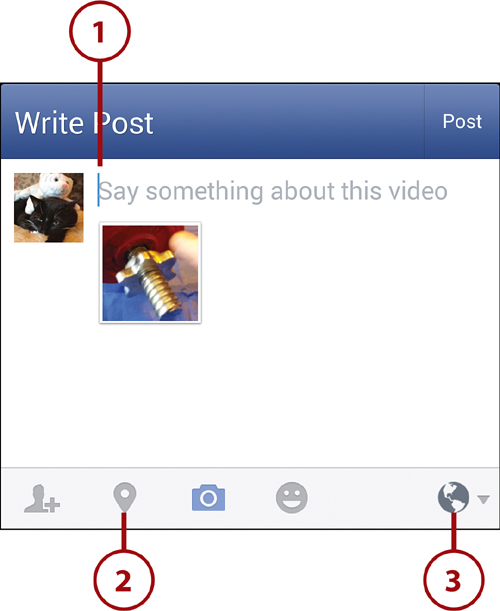
4. Touch Public, Friends, Only Me, or a specific list, as needed.

5. Touch Post to post the video.

Delete Videos
1. Touch and hold the video you want to delete. After a moment, a green check mark appears on the video.
2. Touch to delete the video.


Taking Photos and Videos with the Camera App
The Camera app enables you to take still photos and record videos. You can either shoot photos and videos with the default settings or choose among the many options the Galaxy Note 3 offers.
Take Photos
1. Touch to launch the Camera app. The Camera app opens and displays the input from the rear camera (the main camera) at first.

2. Touch to switch from the rear camera to the front camera so you can take photos of yourself. The front camera is lower resolution than the rear camera, but it works well for capturing candid self-portraits. When you switch to the front camera, the Camera app changes to the Beauty Face mode automatically on the assumption that you want to take a photo of yourself (and that you want to look good).
3. Look at the Mode readout at the top of the screen to see which mode the Camera app is using. For regular shots, you’ll want the Auto mode. You learn about the other modes—and how and when to use them—later in this chapter.

4. Touch to switch to Dual Camera mode. The Camera app displays a stamp-like frame on the screen showing the input from the front camera overlaid on the input from the rear camera. Tap the frame to resize it or reposition it.
5. Touch to take a photo.


Taking a Burst of Photos
Instead of taking a single shot, the Camera app can take a burst of photos. This feature is great when you do not have time to compose your photo perfectly or your subject is moving. To take a burst of photos, touch and hold the shutter release.
Zoom In and Out
Your Galaxy Note 3’s Camera app includes a powerful digital zoom that enables you to close in on the objects you want to photograph.
1. Open the Camera app and point the lens so that your subject occupies the center of the screen.
2. Place two fingers (or a finger and a thumb) on the screen. A zoom indicator appears in the middle of the screen, with a readout showing the zoom factor. A factor of x1.0 represents no zoom.

3. Move your fingers apart to zoom in. The readout shows the zoom factor you’ve reached.
4. Touch to take the photo.

When you need to zoom back out, place two fingers (or a finger and a thumb) on the screen and pinch them together.
Apply Effects to Photos
To make your photos more glamorous, more artistic, or simply more fun, you can apply effects to them. The Camera app includes effects such as Cartoon, Faded Color, Fish Eye, Grayscale, Moody, Oil Pastel, Rugged, Sepia, Tint, Turquoise, Vignette, and Vintage.
1. Touch the > button on the left side of the screen to display the Effects panel.

2. Touch the effect you want to apply. (Touch the No Effect picture at the top of the panel if you need to restore normality.)
3. Touch outside the Effects panel to close the panel.
4. Touch to take the photo.

Change Key Camera Settings
You can get good photos by using your Galaxy Note 3 as a point-and-shoot camera, as described in the previous section. But you can get better photos by changing settings to harness the full power of the Camera app.
1. Touch to display the column of settings icons.
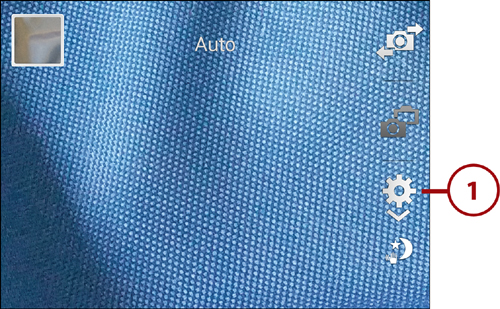
2. Touch to cycle the flash setting among Off, On, and Auto Flash.
Making the Most of the Flash
Choose the Off setting for the flash when you need to take photos where the flash would be disruptive. Choose the On setting when you need to light the foreground of a shot even though the rest of the scene is amply lit—for example, to light your subject’s face in front of a bright background. Choose the Auto setting for general use.
3. Touch to toggle the Smart Stabilization feature on or off. Usually, this feature is helpful when you are taking photos holding the Galaxy Note 3, but you may want to turn it off if you use a tripod or other steadying device.
4. Touch to turn Voice Control on for taking photos. You can then say “Cheese,” “Smile,” “Shoot,” or “Capture” to take photos. (The Camera app responds in the same way to each command. Your subjects may not.)
5. Touch to choose the recording mode for video, which is covered later in the chapter.
6. Touch to display the Share dialog, in which you can choose Off (the default), Share Shot, Buddy Photo Share, ChatON Photo Share, or Remote Viewfinder. See the “Use the Camera App’s Sharing Features” sidebar for details.

7. Touch to hide the column of settings icons.

Choose Advanced Camera Settings
The column of settings icons on the right of the screen lets you control the key settings in the Camera app. But when you need to take complete control of the Camera app, you can open the Settings dialog and work with the full range of settings it offers.
1. Touch the Settings icon to display the Settings column.

2. Touch the Settings icon to display the Settings dialog.

3. Touch to display the settings for still photos.
4. Touch Photo Size to choose the photo size. Normally, it’s best to use either the 4128×3096 pixel resolution (which gives a 4:3 aspect ratio) or the 4128×2322 pixel resolution (which gives a widescreen 16:9 aspect ratio).
5. Touch Burst Shot to enable or disable the Burst Shot feature. Usually, it’s best to keep it on unless you find yourself shooting bursts unintentionally.
6. Touch Tap to Take Pics to enable or disable the Tap to Take Pics feature. When this is on, you can take a photo by touching (tapping) the screen instead of touching the Shutter button.
7. Touch Face Detection to enable or disable the Face Detection feature. This feature attempts to locate faces in the photos you take. You can then tag the faces to identify the people they belong to.

8. Touch Metering to choose the light-metering method. See the nearby Note for details.
9. Scroll down to reach the other settings.
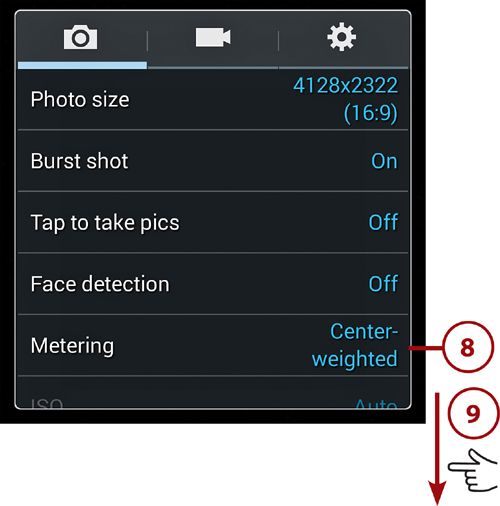

Adjusting the Light Metering for Your Photos
By default, your Galaxy Note 3 uses center-weighted light metering, giving most importance to the light conditions in the center of the photo. Open the Metering dialog and choose Spot instead to base the light metering on the spot you touch in the frame. Choose Matrix to base the metering from samples across the entire frame.
10. Touch ISO to set the ISO rating, which specifies the digital equivalent of film sensitivity. The default setting is Auto, but you can set ISO 100, ISO 200, ISO 400, or ISO 800 manually.
11. Touch Smart Stabilization to use the stabilization feature. This feature helps you avoid taking blurry photos because you’re not holding your Galaxy Note 3 steady.
12. If you’ve set the Mode to Rich Tone (HDR), you can touch Save As and then choose Rich Tone Only to save only the tone-adjusted photo or Rich Tone and Original to save both the tone-adjusted photo and the original photos used to create it. (More on Rich Tone in a moment.)

Why Are Some Settings Unavailable?
Some of the Camera app’s settings depend on each other, so choosing one setting might make another setting unavailable. For example, the ISO setting is available only if you set the Smart Stabilization feature to Off. Similarly, the Save As feature is available only when you have set the Mode to Rich Tone (HDR).
13. Touch to display the settings for shooting video.
14. Touch Video Size to set the video size. For most purposes, 1920×1080 pixel resolution is the best bet because it creates full high-definition video. If you need top quality, choose 3840×2160 pixel resolution.
15. Touch Video Stabilization to enable or disable video stabilization. Normally, using stabilization is a good idea unless you are using a tripod or another device to hold your Galaxy Note 3 still.
16. Touch Audio Zoom to enable or disable audio zoom. You would usually use audio zoom when the audio source is distant from you.

17. Touch to display the general settings for the Camera app.
18. Touch Location Tag to enable or disable adding the GPS location to photos and videos you take. Adding the location enables you to sort the photos and videos by location but may raise privacy issues.
19. Touch Review to enable or disable displaying each photo for review immediately after you take it. Usually, it’s better to shoot photos freely and review them later, especially if your subjects are live and restless and the moments are unrepeatable.
20. Touch Volume Key to choose which function to assign the Volume key when the Camera app is active. Your choices are The Zoom Key, The Camera Key (in other words, the Shutter button), and The Record Key (for starting to shoot video).

21. Touch Timer to open the Timer dialog, in which you can touch 2 Sec, 5 Sec, or 10 Sec to set a delay for taking photos (such as group portraits including the photographer). Touch Off to turn the Timer off.
22. Touch White Balance to change the white balance among Auto, Daylight, Cloudy, Incandescent, and Fluorescent.
23. Scroll down to reach the next settings.
24. Touch Exposure Value to increase or decrease the exposure—for example, increase the exposure when filming against a bright background.
25. Touch Guidelines to turn on a grid of lines that help you compose your shots and orient the camera.
26. Touch Flash to change the flash setting among Off, On, and Auto.
27. Touch Voice Control to enable or disable the Voice Control feature. As mentioned earlier, you can say words such as “Cheese!” to take a photo using your voice.
28. Touch Contextual Filename to include GPS information in the filenames. This feature works only when Location Tag is enabled, so if you enable Contextual Filename when Location Tag is disabled, the Camera app prompts you to enable Location Tag.
29. Scroll down to reach the last few settings.
30. Touch Save as Flipped to change pictures or videos taken on the front camera to mirror images before saving them.

31. Touch Storage to choose between storing the photos on your Galaxy Note 3 (choose Device) and on an SD card you’ve inserted (choose SD Card).
32. Touch Reset if you want to reset the Camera app’s settings to their defaults.
33. Touch outside the Settings dialog to close the dialog.

View the Photos You Take
After taking photos, you can quickly view the photos you have taken, mark them as favorites, share them with other people, or simply delete them.
1. In the Camera app, touch the thumbnail to view the last photo you took.

Zooming In and Out on Your Photos
When viewing a photo, you can zoom in by placing two fingers on the screen and pinching outward or by double-tapping on the area you want to expand. Pinch inward or double-tap again to zoom back out.
2. Touch to display the onscreen controls and the row of thumbnails. They disappear after a few seconds of not being used.
3. Touch to edit the photo. You can rotate it, crop it, apply a color filter, apply an effect, or take other actions.
4. Touch a thumbnail to display its photo; scroll the thumbnails first if necessary. You can also swipe left from the photo displayed; after that, you can swipe either left or right.

5. Touch to open the Select Device dialog, in which you can tap the device to which you want to send the photo.
6. Touch to share the photo. In the Share Via dialog, touch the means of sharing, and then provide any information needed—for example, the recipient for a photo you share via email.
7. Touch to share the photo on Facebook. On the Write Post screen that appears, type the text you want to add, and then touch Post.
8. Touch to delete the photo and then touch OK in the confirmation dialog.
9. Touch to return to the previous screen. You can then touch the Camera icon to return to the Camera app.

Record Videos with the Camera App
Recording videos with the Camera app is even easier than taking still photos because there are fewer options to choose.
1. Touch to launch the Camera app.

2. Touch to switch to the video camera and start recording video.

3. If necessary, place two fingers (or a finger and a thumb) on the screen and pinch apart to zoom in. Pinch together to zoom back out.
4. Touch to pause recording.
5. Touch to stop recording.

Using Automatic and Manual Focusing
While the Camera app is recording video, it automatically adjusts the focus for the object in the center of the screen. If you need to focus on another part of the screen, touch it.
Using Other Features When Recording Video
When recording video, you can use other features such as Dual Camera mode and Effects. Just touch the appropriate icons and choose settings, as described earlier in this chapter.
Choose the Recording Mode for Video
The Camera app can capture special-purpose video as well as normal video. To control which type of video the Camera app captures, you set the recording mode.
1. Touch to display the Recording Mode dialog.
2. Touch Normal to return to Normal mode. Normal mode is suitable for general-purpose shooting.
3. Touch Limit for MMS to shoot low-resolution video suitable for sending via instant messaging (which cannot transmit large files).
4. Touch Slow Motion to shoot at a high frame rate that will play back in slow motion. You would normally use slow motion as a special effect—for example, to create a dreamlike effect.
5. Touch Fast Motion to shoot at a high frame rate that will play back in fast motion. You would normally use fast motion as a special effect—for example, for comedy.
6. Touch Smooth Motion to shoot at a high frame rate that will play back at normal speed. You would normally use smooth motion for shooting sports, animals, and moving objects.
7. Touch outside the Recording Mode dialog to close the dialog.

Enjoying Videos with the YouTube App
Your Galaxy Note 3 comes with a YouTube app that enables you to find and watch videos, rate them, add them to your favorites, and share links with other people. The app even enables you to upload your own videos to YouTube.
Meet the YouTube Main Screen
1. Touch the YouTube icon to launch the YouTube app.

2. Touch to search YouTube using keywords.
3. Touch Uploads to see the list of videos you’ve uploaded.
4. Touch History to display the History screen, which enables you to return to videos you watched earlier.
5. Touch Favorites to display the list of videos you’ve marked as your favorites. Marking a video as a favorite enables you to return to it easily even after it has disappeared from your History list.
6. Touch Playlists to display the Playlists screen, which lists any playlists you have created.
7. Touch Watch Later to display the Watch Later screen, which contains any videos you have marked for watching later.
8. Touch What to Watch to display the What to Watch screen, which contains recommendations for you.

9. Touch My Subscriptions to display the Videos screen, which shows updates from the channels you have added.
10. Touch Browse Channels to display the Browse Channels screen, which contains channels such as Recommended for You, Most Subscribed, Most Viewed, and Local.
11. Swipe left if you want to close the Account pane without navigating to another screen from it.

12. Touch a channel to display its screen. You can then touch a video to display more information about it and play it.

Play a Video
While playing a YouTube video, you can rate the video, read comments about it, or share it with other people.
1. Touch the video to display the onscreen controls for a few seconds.
2. Touch to start or pause the video.
3. Touch to switch the video to full screen in Landscape mode.
4. Drag to scrub forward or backward through the video.
5. Touch to display the Add To dialog, from which you can add the video to your Watch Later list, your Favorites list, or a playlist.
6. Touch to share the video’s link (its URL) via apps such as Gmail, Facebook, or Twitter.
7. Touch to see information about the video, including who uploaded it, the video title, description, and how many times it has been viewed.
8. Touch to see the YouTube channel of the person who uploaded the video.
9. Touch to like the video.
10. Touch to dislike the video.
11. Touch to subscribe to this channel.
12. Touch to flag the video as inappropriate—for example, for hateful or abusive content, or because it infringes your rights.
13. Touch to display choices for the video, such as watching it with closed captioning (CC) or in high definition (HD).


Change YouTube Settings
To get more out of YouTube, you might want to change your settings. Your options include choosing whether to watch high-quality videos on cellular connections, clearing your YouTube search history, and enabling the preloading of items on your subscriptions list or your Watch Later list.
1. From within the YouTube app, touch the Menu button.
2. Touch Settings.
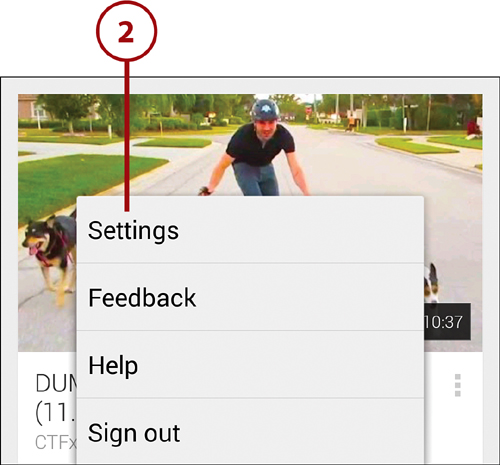
3. Touch General.
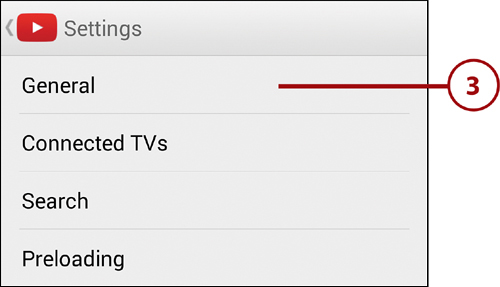
4. Touch High Quality on Mobile to enable or disable always starting videos in High Quality mode. The video might take longer to start playing, and it uses more data in High Quality mode.
5. Touch Caption Font Size to set the size of the font used when a video has captions.
6. Touch Uploads to choose when your Galaxy Note 3 uploads videos to YouTube. Your choices are Only When on Wi-Fi or On Any Network.
7. Touch Content Localization to choose a specify country or region that you want to prioritize—for example, the country you live in.
8. Touch Improve YouTube to enable or disable sending anonymous usage data to YouTube to help improve the service.
9. Touch New Video Notifications to enable or disable receiving notifications of new videos that YouTube claims may match your interests.
10. Touch to return to the main Settings screen.

12. Touch to pair your Galaxy Note 3 with a TV so you can broadcast to the TV.
13. Touch to edit your list of paired TVs. You can rename a TV for clarity or remove a TV you no longer want to use.
14. Touch to return to the main Settings screen.
15. Touch Search.
16. Touch to clear your YouTube search history. Touch OK in the Clear Search History? dialog that opens.
17. Touch to enable the Never Remember History feature, which prevents YouTube from ever storing your search history.
18. Touch to set the types of videos that are displayed when you search. Your choices are Don’t Filter and Strict. If you set this setting to Don’t Filter, no videos are filtered out based on content.
19. Touch to return to the main Settings screen.
20. Touch Preloading.
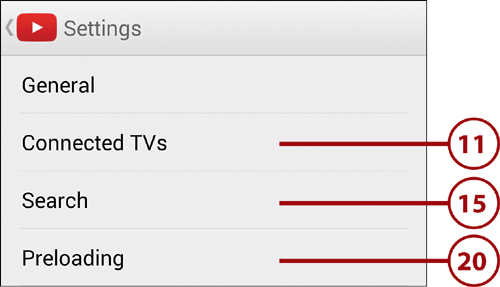


21. Touch to enable or disable preloading of videos to which you have subscribed. Preloading videos enables you to start watching them sooner on slow networks, but storing the files takes up space on your Galaxy Note 3.
22. Touch to enable or disable preloading of videos you have added to your Watch Later list.
23. Touch to return to the main Settings screen.

24. Touch the Back button or the YouTube button to return to the YouTube app.
Upload a Video to YouTube from the YouTube App
After you create your own channel, you can easily upload your videos to YouTube straight from the YouTube app.
1. On the YouTube navigation panel, touch Uploads to display your Uploads screen.

2. Touch to start uploading a video.

3. In the Choose Video to Upload dialog, touch the source of the video. For example, touch Gallery.

4. Touch the video you want to upload.

5. On the Upload Video screen, enter the information for the video, as discussed earlier in this chapter, and then touch Upload.
